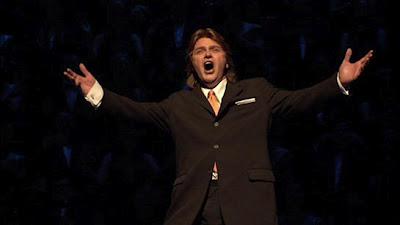by Paul J. Pelkonen

Prize singer: Klaus Florian Vogt is one of the finest heroic tenors working today.
Image from Act III of the DVD of Wagner's Die Meistersinger von Nürnberg
© 2008 Opus Arte/Bayreuth Festspiele.
Tenors have the unenviable task of singing difficult high music, pulling off feats of vocal stamina and dexterity that make them among the most revered (and sometimes the most despised) opera singers. (They also show up frequently in rock and roll, where some noted tenors include Rob Halford from Judas Priest, Bruce Dickinson from Iron Maiden and the late Freddie Mercury.) From the six-hour marathons of Wagners operas to the stunning "Ah, mes amis" by Donizetti (which requires nine high Cs in a row!) the life of a star tenor is never easy.
Let's start with an example of really fine tenor singing:
Jonas Kaufmann sings In Fernem Land from Act III of Wagner's Lohengrin. Footage from the Bayerische Staatsoper © 2009 Decca/Universal Classics.
The rewards can be worth it. Most of the famous male opera singers, (the ones that you've heard of even if you've never been to the opera) are tenors. Enrico Caruso. Lauritz Melchior. Richard Tucker. In the '80s and '90s, the operatic world was dominated by the Three Tenors: Plácido Domingo, José Carreras and the late Luciano Pavarotti. Today, the torch is carried by a modern generation of star tenors: Klaus Florian Vogt, Jonas Kaufmann, Juan Diego Flórez and Roberto Alagna.

Tenors come in many shapes, sizes and styles, but all have in common a range from the B above "low" C to the C one octave above "middle" C. Tenors are measured on a loose scale of "heaviness" with the largest, and most demanding parts referred to as the "heavier" roles. Despite the girth of some singers, it has nothing to do with body weight.
Countertenors:These are singers who trained as tenors but make their sound exclusively from the "head", enabling them to sing very high notes with a tone is the equivalent of an alto. Heard frequently in baroque opera parts.
Examples: Arsamene in Handel's Xerxes, Oberon in Britten's A Midsummer Night's Dream.
David Daniels sings Ombra mai fu from Handel's Xerxes.
Light (buffo) Tenor:
This type of tenor voice was popular in the 1800s appearing in bel canto works by Rossini and Donizetti as well as the operas of Mozart. The very top of the range.
Examples: Count Almaviva in Rossini's Il Barbiere di Siviglia.
Juan Diego Flórez hits nine high Cs in a row in Donizetti's La fille du Régiment.) Footage © 2008 The Metropolitan Opera.
Lyric Tenor:
This is the most common type of tenor voice. Young romantic heros (or in the case of Verdi's Rigoletto, romantic villains. A lyric must be able to sing with grace and liquidity of tone, and be charming. Lyrics who take on "heavier" roles are called spinto tenors, which literally means "pushed." But if you push too hard, the voice thickens and then you can no longer sing the lyric parts. In other words, bel canto becomes "can belto."
Examples: Don Ottavio in Mozart's Don Giovanni, Nemorino in Donizetti's L'Elisir d'Amore.
Luciano Pavarotti as the Duke in Verdi's Rigoletto. Footage © 1981 The Metropolitan Opera.
Character Tenor:
Less common but equally important, these are singers who spend a lot of time acting with their voices and sometimes making (deliberately) ugly sounds to portray complex dramatic figures. Character tenors are tapped to play older men, villains and authority figures like the Emperor in Puccini's Turandot.
Examples: Mime in the Ring, the Captain in Wozzeck, Captain Vere in Billy Budd.
The late Philip Langridge as Captain Vere in Benjamin Britten's Billy Budd. Footage © Royal Opera at Covent Garden.
Dramatic Tenor:
As orchestras got bigger in the 19th century, singers compensated by developing the powerful high C from the chest. This full-on "trumpet blast" is the calling card of the dramatic tenor: who will take on the challenging roles of the late Verdi and Puccini heroes and some of the operas of Wagner.
Examples: Radames in Aida, the title role in Don Carlos.
Plácido Domingo sings "La vita è inferno all'infelice" from Verdi's La Forza del Destino Footage © 1996 The Metropolitan Opera
Heldentenor: ("Heroic Tenor")
These are rare: power-house singers who can make a clean tone (or a clean bellow, in som cases) over an enormous, thundering orchestra. A staple of German opera, there are also Italian tenor parts written for this voice like the title role of Verdi's Otello.
Examples: The title roles in Otello and Siegfried.
Siegfried Jerusalem sings the Forging Song from Act I of Wagner's Siegfried. Footage © 1989 The Metropolitan Opera.

